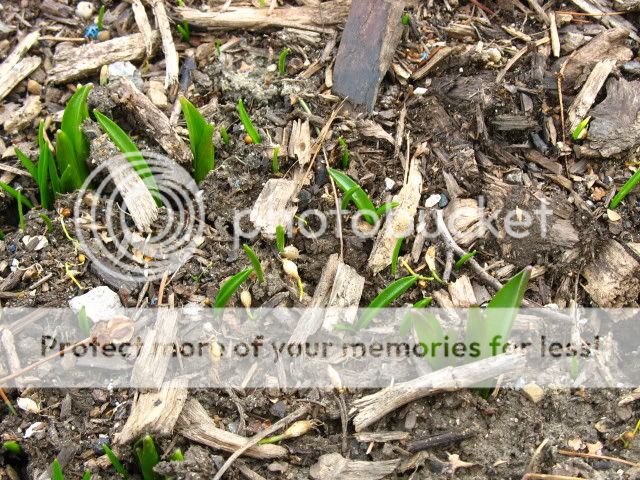“April comes in like an idiot,
babbling and strewing flowers.”
–Edna St. Vincent Millay
Well, I’m not sure it’s so idiotic, but April certainly is strewing flowers! Or, if not flowers, then lots of shoots that will eventually bloom. Here are some of the pleasant surprises in my garden beds lately.
The hyacinths are nicely budded out…

The ‘Pink Giant’ Chionodoxa (a gift from my friend Stephanie for a certain BIG birthday) are just about ready to go…

And the ‘Ice Follies’ Daffodils have been going strong for a while now.

Hooray! Mr. Squirrel did NOT find all of my lily bulbs. It looks like most of them are coming back, except for a couple I was pretty sure he had carted home for dinner.

I am also breathing a sigh of relief over Ligularia ‘The Rocket.’

I had planted one of these in the same spot a couple of years ago (the only part of my yard that is moist enough for it), but it did not survive the winter. This time, I mounded soil over the crown for a little extra protection, and it looks like it worked! It’s hard to believe these tiny little leaves will soon be several inches across.
Aquilegia seedlings are bursting forth everywhere, mostly because I helped with some of the “strewing” in this case.

I hope these will look like their dearly departed mother, Aquilegia ‘Cardinal.’ She was a real beauty.

But Columbines are notoriously promiscuous in their cross-breeding. With my luck, the babies will all take after the common blue variety from the other side of the yard.
Perhaps my greatest thrill (doesn’t take much for us gardeners, does it?) was finding these poppy seedlings—about 16 at last count.

I’ve been trying to establish a patch of poppies in my garden since we moved here almost five years ago, but with no luck. Mr. BrownThumb suggested scattering the seed over the ground in February (even over snow, if need be). I had dutifully been planting them after the last frost, as suggested on the seed package. (For the record, I recently did an informal survey of poppy packets in three different garden centers. Only one suggested planting them during the winter.) Thanks, Mr. BT! It looks like it worked!
Now I’m just crossing my fingers that they will come out the right color. They’re supposed to be Shirley poppies—nice soft pinks, reds, salmons, and whites. The last time I got this variety to grow, all but one came out bright orange, and I don’t do much orange in my gardens. I ripped them all out (after they bloomed but before they set seed) except the one pink one, and of course it didn’t multiply. Maybe I cursed myself to several years of bad poppy karma?
Yes, there are lots of pleasant new developments in the garden every time I venture outside during this idiotic, flower-strewing month. But there are a few less-pleasant developments as well…

I guess these devilish not-so-dandy-lions were bound to show up sooner or later. But did it have to be so early? And right where I just mulched to prevent them?
I’m also disappointed that no tulips are blooming yet. Yesterday, I pulled out my garden journals from 2005 and 2006 (the last years I tried keeping a journal: in both cases I started out with a bang, then quit by the end of June). Back then, my species tulips were blooming away by now. This year, the buds are just beginning to emerge. I’m not sure what to attribute the difference to, but I am certain they will soon add their rainbow splashes of color to the landscape.
And then, no doubt, I will be the one babbling and gushing over them like an idiot.





















